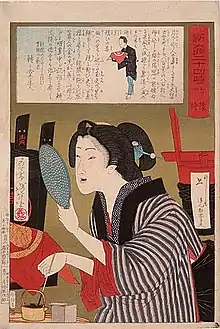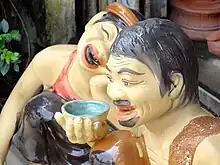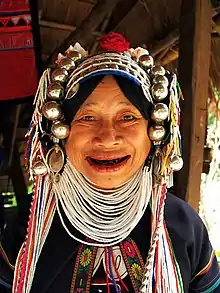Teeth blackening or teeth lacquering is a custom of dyeing one's teeth black. It was most predominantly practiced in Southeast Asian and Oceanic cultures, particularly among Austronesian, Austroasiatic, and Kra–Dai-speaking peoples. It was also practiced in Japan prior to the Meiji era, as well as in India.[1][2] It was also performed among some groups in the Americas, most notably among the Shuar people of northern Peru and Ecuador.[3]
Teeth blackening is usually done during puberty. It was primarily done to preserve the teeth into old age, as it prevents tooth decay similar to the mechanism of modern dental sealants. It was seen as a sign of maturity, beauty, and civilization. A common belief is that blackened teeth differentiated humans from animals. Teeth blackening is often done in conjunction with traditions of tooth sharpening and dental evulsion, as well as other body modification customs like tattoos. Teeth blackening and filing were regarded with fascination and disapproval by early European explorers and colonists.
The practice survives in some isolated ethnic groups in Southeast Asia and Oceania but has mostly disappeared after the introduction of Western beauty standards during the colonial era.[1][2][3] It is mainly prevalent in older women, though the practice is still carried on by some younger women. Sometimes artificial teeth are used to achieve blackened teeth.
Teeth blackening is commonly confused with the red-stained teeth from betel chewing. However, betel chewing damages the teeth and gums, while teeth blackening does not.[1][2]
East and Southeast Asia
Japan

In Japan, teeth blackening is known as ohaguro (お歯黒). Ohaguro existed in one form or another for hundreds of years, and was seen amongst the population as beautiful until the end of the Meiji period (1868–1911). Objects that were pitch black, such as glaze-like lacquer, were seen as beautiful.
Name
The word ohaguro was an aristocratic term. There is an alternate term for ohaguro, kane (鉄漿, lit. 'iron drink'). At the old Imperial palace in Kyoto, it was called fushimizu (五倍子水). Among civilians, such words as kanetsuke (鉄漿付け), tsukegane (つけがね) and hagurome (歯黒め) were used.
History
Traces of blackened teeth can be seen in the buried bones and haniwa of the Kofun period (300–538 CE). References to ohaguro exist in The Tale of Genji[4] and Tsutsumi Chūnagon Monogatari. At the end of the Heian period, at the time when aristocratic men and women reached puberty and celebrated their genpuku or mogi, the Taira clan and other samurai, and pages working at large temples, dyed their teeth using kanemizu, a solution made from ferric acetate, created from soaking iron filings in vinegar, and tannins, derived from vegetables or tea.[5] The Imperial family and other high-ranking aristocrats who had finished their hakamaza (ceremony where a child is fitted with a hakama) blackened their teeth and painted their eyebrows (hikimayu (引眉)). This was done in the Imperial household until the end of the Edo era.
In the Muromachi period (1336–1573), ohaguro was generally seen among adults, though when the Sengoku period (1467–1615) began, so as to prepare for political marriages of convenience, when the daughters of military commanders were around 8 to 10 years old, they would blacken their teeth as a marking of their coming of age. Relatives and guardians of the bride who blackened their teeth were called kaneoya (鉄漿親). It is said that military commanders who were struck in the head on the battlefield and who did not want to be ugly would wear average women's makeup and would blacken their teeth. These faces imitated the Noh masks of women and young boys.
After the Edo period (1603–1867), only men of the Imperial House of Japan and the aristocracy blackened their teeth. Due to the odor and labor required for the process, as well as a feeling among young women that they were ageing, ohaguro was done only by married women, unmarried women who were older than 18, sex workers and geisha. For rural people, ohaguro was done only at times of special celebrations, such as Japanese festivals, wedding ceremonies, and funerals. There were also depictions of ohaguro in fairy tales, such as "Gon, the Little Fox".
On February 5, 1870, the government banned ohaguro and the process gradually became obsolete. After the Meiji period, it temporarily spread, but it almost entirely died out in the Taishō period (1912–1926).
In contemporary times, the only places where ohaguro can be seen is in plays, on some older apprentice geisha, some festivals, and movies.
Vietnam



In Vietnam, tooth painting was practiced by the majority Vietnamese people as well as by minority ethnic groups. Si La men paint their teeth red and the women paint theirs black. This practice has slowly declined with each new generation. The Baiyue in southern China and northern Vietnam also practiced teeth blackening.[6]: 1–2 When Han Chinese ruled the Vietnamese in the Fourth Chinese domination of Vietnam due to the Ming dynasty's conquest during the Ming–Hồ War, they imposed the Han Chinese style of men wearing long hair on short haired Vietnamese men. The Vietnamese people were ordered to stop cutting and instead grow their hair long and switch to Han Chinese clothing in only a month by a Ming official. Ming administrators said their mission was to "civilize" the unorthodox, by Han Chinese standards, appearance of the Vietnamese.[7]
The Ming dynasty only wanted the Vietnamese to wear long hair and to stop teeth blackening so they could have white teeth and long hair like Chinese.[8] A royal edict was issued by Vietnam in 1474 forbidding Vietnamese from adopting foreign languages, hairstyles and clothes like that of the Lao, Champa or the "Northerners" which referred to the Ming. The edict was recorded in the 1479 Complete Chronicle of Dai Viet of Ngô Sĩ Liên.[9]
A passage in the biography of a Korean trader that went to Vietnam, Jowanbyeokjeon (Korean: 조완벽전; Hanja: 趙完璧傳), also mentions these customs,[10]
其國男女皆被髮赤脚。無鞋履。雖官貴者亦然。長者則漆齒。 (In that country, both men and women all tie up their hair and go barefoot, without shoes or sandals. Even officials and nobility are the same. As for the respected individuals, they blacken their teeth.)
The Philippines
In the Philippines, Spanish colonial official and historian, Antonio de Morga, recorded in his book, Sucesos de las Islas Filipinas (1609), on how local men and women of the Philippines cared and presented themselves at the time. It was noted by Morga:
All are very careful of their teeth, which from a very early age they file and render even, with stones and iron. They dye them a black color, which is lasting, and which preserves their teeth until they are very old, although it is ugly to look at.
The late 19th century Filipino nationalist, writer, and polymath, José Rizal, commented in his annotations to Morga's account that: "This custom still exists... This custom exists also among the married women of Japan, as a Sign of their chastity. It is now falling into disuse."
Thailand
In Thailand, teeth darkening was an established symbol of beauty, achieved for centuries with a paste called misi,[11] and love poems used to compare the dyed teeth of the beloveds to ebony and other valuable woods.[12] When the 19th-century Thai king Mongkut lost his teeth, he replaced them with artificial teeth carved from dark red sappan wood.[12]
Eastern India
Colouring teeth black was a tradition practised by various tribes of Eastern Himalayas, Naga Hills and Manipur in India, such as the Konyak Nagas and the Wancho Nagas.
Other areas
Teeth blackening has been documented throughout a number of other peoples in the Far East:
- China
- Taiwan
- Laos
- Philippines
- Pacific Islands[13]
- Thailand
- Akha
- Lisu
- Vietnam
South Asia
Teeth blackening was also documented across Islamic culture in South Asia:
The agent of choice for teeth blackening became known as missī, a powdery mixture of (1) iron and copper sulphate, (2) a plant source of tannins, such as myrobalans, and (3) flavouring agents. The use of missī, thought to be sanctified by Fāṭimah, the Prophet's daughter, became deeply engrained in Islamic culture across much of the subcontinent. Teeth blackening as a life cycle event related to sexual maturity and in its literary portrayals acquired distinct sexual overtones. It was integrated into the culture of courtesans and prostitutes where missī became synonymous with the ritual of selling a woman’s virginity. Although not a primary motivation, medicinal considerations also played a role in the use of missī. Early references to blackening the gums and edges of the teeth suggest a connection to an older tradition of filing the interstices between teeth which had become prohibited by Islamic law. Geographically and culturally distinct traditions of teeth blackening also prevailed among diverse indigenous groups living along the slopes of the Eastern Himalayas, from Nepal through Meghalaya and Assam to Nagaland. Here teeth were blackened by applying the wood tar of specific plants or chewing specific plant products. These practices related technologically and culturally to the wide-spread teeth blackening traditions of island and mainland South-east Asia and beyond.[14]
There is also evidence of the use of misi in India among some practitioners of Hinduism, mainly to blacken the gums and sometimes the teeth; the 16th century poet Malik Muhammad Jayasi dedicated some lines in his epic poem Padmavat to the smile of the princess Rani Padmini, who ruled Chittorgarh in the 13th century, in which he compares her teeth to diamonds on black pedestals:
Her teeth, like diamonds on a pedestal:
between each, deep, deep black.
Like a gleam of lightning in a dark Autumn night,
so are these thirty-two caused to flash.— —Malik Muhammad Jayasi [15]
Africa
Further West, teeth blackening has been documented as far as Madagascar.[16]
References
- 1 2 3 Zumbroich, Thomas J. (2009). "'Teeth as black as a bumble bee's wings': The ethnobotany of teeth blackening in Southeast Asia". Ethnobotany Research & Applications. 7: 381–398. doi:10.17348/era.7.0.381-398. Archived from the original on 2015-09-17. Retrieved 2019-01-27.
- 1 2 3 Zumbroich, Thomas (2015). "We Blacken Our Teeth with Oko to Make Them Firm: Teeth Blackening in Oceania". Anthropologica. 57: 539–555. Archived from the original on 2020-09-24. Retrieved 2019-01-27.
- 1 2 Pinchi, Vilma; Barbieri, Patrizia; Pradella, Francesco; Focardi, Martina; Bartolini, Viola; Norelli, Gian-Aristide (15 March 2015). "Dental Ritual Mutilations and Forensic Odontologist Practice: a Review of the Literature". Acta Stomatologica Croatica. 49 (1): 3–13. doi:10.15644/asc49/1/1. PMC 4945341. PMID 27688380.
- ↑ Murasaki Shikibu, The Tale of Genji, translated by Royall Tyler. Chapter 6, page 130. Penguin Classics. Reprint 2003. First published 2001. ISBN 0-14-243714-X - see also note 57 by Royall Tyler
- ↑ "Ohaguro: The Beauty of Blackened Teeth in Old Japan | LIVE JAPAN travel guide". LIVE JAPAN. Retrieved 2023-08-14.
- ↑ Milburn, Olivia (2010). The Glory of Yue: An Annotated Translation of the Yuejue shu. Sinica Leidensia. Vol. 93. Brill Publishers.
- ↑ The Vietnam Review: VR., Volume 3. Vietnam Review. 1997. p. 35. Archived from the original on 2021-05-18. Retrieved 2021-02-24.
- ↑ Baldanza, Kathlene (2016). Ming China and Vietnam: Negotiating Borders in Early Modern Asia. Cambridge University Press. p. 110. ISBN 978-1316531310. Archived from the original on 2021-05-18. Retrieved 2021-02-24.
- ↑ Dutton, George; Werner, Jayne; Whitmore, John K., eds. (2012). Sources of Vietnamese Tradition. Introduction to Asian Civilizations (illustrated ed.). Columbia University Press. p. 87. ISBN 978-0231511100. Archived from the original on 2021-05-18. Retrieved 2021-02-24.
- ↑ 李, 睟光. 趙完璧傳 (조완벽전).
- ↑ Keshavdas (1990). K. P. Bahadur (ed.). Rasikapriya of Keshavadasa. Motilal Banarsidass Publ. pp. 53–54. ISBN 8120807340.
And the ebony bark, in its core beneath Was never so black as thy shiny teeth.
- 1 2 DeMello, Margo (2012). "Teeth Painting". Faces Around the World: A Cultural Encyclopedia of the Human Face. ABC-CLIO. pp. 288–289. ISBN 978-1598846171.
- ↑ Sheila Benavente. "Mariana's Past". Offisland.com. Archived from the original on 2012-03-09. Retrieved 2012-12-21.
- ↑ Zumbroich, Thomas J. (2015). "The missī-stained finger-tip of the fair': A cultural history of teeth and gum blackening in South Asia". eJournal of Indian Medicine. 8 (1): 1. Archived from the original on 2015-10-19. Retrieved 2015-02-26.
- ↑ Keshavdas, 1990, pp. 53-54
- ↑ "Zumbroich, Thomas J. 2012. 'Ny vazana tsy aseho vahiny' - 'Don't show your molars to strangers' - Expressions of teeth blackening in Madagascar. Ethnobotany Research & Applications 10:523-539". Archived from the original on 2015-10-19. Retrieved 2015-02-25.
External links
- Ohaguro tools (in Japanese)

